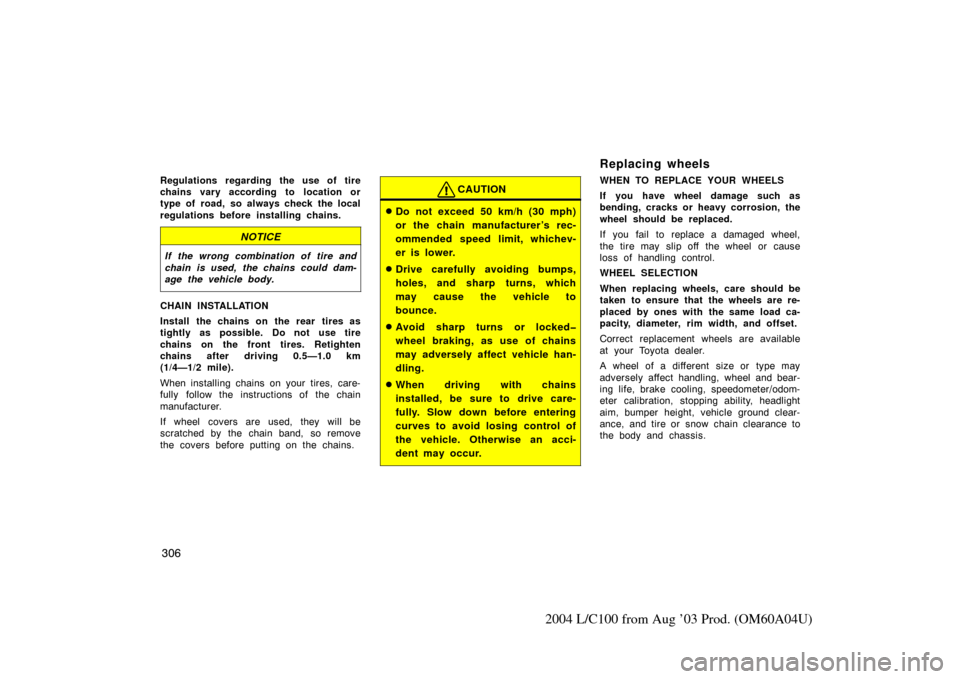Page 314 of 342

306
2004 L/C100 from Aug ’03 Prod. (OM60A04U)
Regulations regarding the use of tire
chains vary according to location or
type of road, so always check the local
regulations before installing chains.
NOTICE
If the wrong combination of tire and
chain is used, the chains could dam-
age the vehicle body.
CHAIN INSTALLATION
Install the chains on the rear tires as
tightly as possible. Do not use tire
chains on the front tires. Retighten
chains after driving 0.5—1.0 km
(1/4—1/2 mile).
When installing chains on your tires, care-
fully follow the instructions of the chain
manufacturer.
If wheel covers are used, they will be
scratched by the chain band, so remove
the covers before putting on the chains.
CAUTION
�Do not exceed 50 km/h (30 mph)
or the chain manufacturer’s rec-
ommended speed limit, whichev-
er is lower.
�Drive carefully avoiding bumps,
holes, and sharp turns, which
may cause the vehicle to
bounce.
�Avoid sharp turns or locked�
wheel braking, as use of chains
may adversely affect vehicle han-
dling.
�When driving with chains
installed, be sure to drive care-
fully. Slow down before entering
curves to avoid losing control of
the vehicle. Otherwise an acci-
dent may occur.
Replacing wheels
WHEN TO REPLACE YOUR WHEELS
If you have wheel damage such as
bending, cracks or heavy corrosion, the
wheel should be replaced.
If you fail to replace a damaged wheel,
the tire may slip off the wheel or cause
loss of handling control.
WHEEL SELECTION
When replacing wheels, care should be
taken to ensure that the wheels are re-
placed by ones with the same load ca-
pacity, diameter, rim width, and offset.
Correct replacement wheels are available
at your Toyota dealer.
A wheel of a different size or type may
adversely affect handling, wheel and bear-
ing life, brake cooling, speedometer/odom-
eter calibration, stopping ability, headlight
aim, bumper height, vehicle ground clear-
ance, and tire or snow chain clearance to
the body and chassis.
Page 315 of 342

307
2004 L/C100 from Aug ’03 Prod. (OM60A04U)
Replacement with used wheels is not rec-
ommended as they may have been sub-
jected to rough treatment or high mileage
and could fail without warning. Also, bent
wheels which have been straightened may
have structural damage and therefore
should not be used. Never use an inner
tube in a leaking wheel which is designed
for a tubeless tire.
CAUTION
Observe the following instructions.
Otherwise, an accident may occur re-
sulting in death or serious injuries.
�Do not use wheels other than the
manufacturer ’s recommended size,
as this may cause dangerous han-
dling characteristics resulting in
loss of control.
�Do not use wheels of different
brands, sizes and types, as this
may cause dangerous handling
characteristics resulting in loss of
control.
Aluminum wheel precautions
�When installing aluminum wheels,
check that the wheel nuts are tight
after driving your vehicle the first 1600
km (1000 miles).
�If you have rotated, repaired, or
changed your tires, check that the
wheel nuts are still tight after driving
1600 km (1000 miles).
�When using tire chains, be careful not
to damage the aluminum wheels.
�Use only the Toyota wheel nuts and
wrench designed for your aluminum
wheels.
�When balancing your wheels, use only
Toyota balance weights or equivalent
and a plastic or rubber hammer.
�As with any wheel, periodically check
your aluminum wheels for damage. If
damaged, replace immediately.
Page 330 of 342
322
2004 L/C100 from Aug ’03 Prod. (OM60A04U)
Dimensions and weights
Overall length mm (in.) 4890 (192.5)
Overall width mm (in.) 1940 (76.4)
Overall height mm (in.) 1875 (73.8)
∗1
Wheelbase mm (in.) 2850 (112.2)
Front tread mm (in.) 1620 (63.8)
Rear tread mm (in.) 1615 (63.6)
Vehicle capacity weight
(occupants + luggage)
kg (lb.) 545 (1200)
Towing capacity
(trailer weight + cargo weight) kg (lb.) 2948 (6500)
∗1: Unladen vehicle
Engine
Model:
2UZ− FE
Type: 8 cylinder V type, 4 cycle, gasoline
Bore and stroke, mm (in.): 94.0 � 84.0 (3.70 � 3.30)
Displacement, cm
3 (cu. in.):
4664 (284.6)
Fuel
Fuel type: Unleaded gasoline, Octane Rating 87
(Research Octane Number 91) or higher.
For improved vehicle performance, the
use of premium unleaded gasoline with
an Octane Rating of 91 (Research Oc-
tane Number 96) or higher is recom-
mended.
Fuel tank capacity, L (gal., Imp. gal.): 96 (25.4, 21.1)
Page 332 of 342

324
2004 L/C100 from Aug ’03 Prod. (OM60A04U)
AUTOMATIC TRANSMISSION
Fluid capacity (drain and refill), L (qt.,
Imp. qt.) Up to 3.0 (3.2, 2.6)
Fluid type: “Toyota Genuine ATF WS”
Change automatic transmission fluid
only as necessary.
Generally, it is necessary to change au-
tomatic transmission fluid only if your
vehicle is driven under one of the Spe-
cial Operating Conditions listed in your
“Scheduled Maintenance Guide” or
“Owner ’s Manual Supplement”. When
changing the automatic transmission
fluid, use only “Toyota Genuine ATF
WS” (ATF JWS3324 or NWS9638) to aid
in assuring maximum transmission per-
formance.
Notice: Using automatic transmission
fluid other than “Toyota Genuine ATF
WS” may cause deterioration in shift
quality, locking up of your transmission
accompanied by vibration, and ultimate-
ly damage the automatic transmission
of your vehicle. TRANSFER
Oil capacity, L (qt., Imp. qt.)
1.3 (1.4, 1.1)
Oil type: Gear oil API GL −4 or GL −5
Recommended oil viscosity: SAE 75W −90
DIFFERENTIAL
Oil capacity, L (qt., Imp. qt.): Front 1.6 (1.7, 1.4)
Rear 3.3 (3.5, 2.9)
Oil type: Hypoid gear oil API GL −5
Recommended oil viscosity: Above −18 C (0 F)
SAE 90
Below −18 C (0 F)
SAE 80W or 80W −90 CHASSIS LUBRICATION
Wheel bearings:
Lithium base wheel bearing grease,
NLGI No.2
Front drive shaft thrust bushings: Synthetic oil and lithium soap base
chassis grease, NLGI No.1
Propeller shafts: SpidersLithium base chassis grease, NLGI
No.2
Slide yoke Lithium base chassis grease, NLGI
No.2 or Molybdenum—disulfide lithium
base chassis grease, NLGI No.2
Page 333 of 342
325
2004 L/C100 from Aug ’03 Prod. (OM60A04U)
BRAKES
Minimum pedal clearance when depressed
with the force of 490 N (50 kgf, 110 lbf)
with the engine running, mm (in.): 116 (4.6)
Pedal free play, mm (in.): 1—6 (0.04—0.24)
Pad wear limit, mm (in.):
1.0 (0.04)
Lining wear limit, mm (in.): 1.0 (0.04)
Parking brake adjustment when pulled with
the force of 196 N (20 kgf, 44 lbf): 4—6 clicks
Fluid type: SAE J1703 or FMVSS No.116 DOT 3
STEERING
Wheel free play: Less than 40 mm (1.6 in.)
Power steering fluid type: Automatic transmission fluid DEXRON
\bII
or III
Page 334 of 342
326
2004 L/C100 from Aug ’03 Prod. (OM60A04U)
Tires
Tire size and inflation pressure:kPa (psi)
Ti r e siz e
FrontRearWheel sizeNormal drivingTr ailer towingNormal drivingTr ailer towing
P275/65R17 113S200 (29)220 (32)220 (32)240 (35)17 � 8JJ
P275/60R18 111H200 (29)220 (32)220 (32)240 (35)18 � 8JJ
Wheel nut torque, N·m (kgf·m, ft·lbf): 131 (13.4, 96.6)
NOTE: For a complete information on tires (e.g. replacing tires or replacing wheels), see “Checking tire inflation pressure” on page 299 through “Aluminum wheel precautions” on page 307.
Page 336 of 342

328
2004 L/C100 from Aug ’03 Prod. (OM60A04U)
26. HEAD (LH�LWR) 10 A: Left−hand head-
light (low beam)
27. HEAD (RH�UPR) 20 A: Right−hand
headlight (high beam)
28. HEAD (LH�UPR) 20 A: Left−hand head-
light (high beam)
29. PWR OUTLET 15 A: Power outlets
30. CIG 15 A: Cigarette lighter
31. ACC 7.5 A: Instrument panel light
32. AM1 7.5 A: Multiport fuel injection sys-
tem/Sequential multiport fuel injection
system
33. DEFOG 20 A:
Rear window defogger
34. AHC�B 15 A: Active height control sus-
pension (AHC)
35. FUEL HTR 20 A: Fuel heater
36. POWER HTR 7.5 A: Power heater
37. AHC�IG 20 A: Active height control sus-
pension (AHC)
38. EFI or ECD No.2 10 A: Emission control
system
39. GAUGE1 10 A: Gauges and meters
40. ECU�IG1 10 A: Multiport fuel injection
system/S equential multiport fuel injec-
tion system
41. ECU�B1 10 A:
Navigation system
42. DBL LOCK 15 A: Double lock system
43. BATT CHARGE 30 A
44. A/C 15 A:
Air conditioning system
45. STOP 15 A: Stop lights
46. OBD�2 7.5 A: On−board diagnosis system
47. IDEL UP 7.5 A: Idle−up system
48. LH SEAT 30 A: Power seat system
49. DOOR 25 A: Power door lock system,
Power windows
50. SUN ROOF 25 A: Electronic moon roof
51. RR WIPER 15 A: Rear wiper system
52.ECU�B2 10 A: Power door lock system,
Power window
53. DIFF 20 A: Four−wheel drive system
54. WASHER 15 A: Windshield washer
55. RADIO 10 A: Audio system
56. DOME 10 A: Interior lights
57. VGRS 40 A: Variable gear ratio steer-
ing system
58. P/W (FL) 20 A: Power window
59. P/W (RL) 20 A: Power window
60. WIPER 25 A: Windshield wiper
61. ECU�IG2 10 A: Rear air conditioning
system
62. SEAT HTR 15 A: Seat heater 63. GAUGE2 10 A:
Back−up lights
64. MET 7.5 A: Gauges and meters
65. IGN 7.5 A: Multiport fuel injection sys-
tem/Sequential multiport fuel injection
system
66. SECURITY 7.5 A: Theft deterrent sys-
tem
67. P/W (RR) 20 A: Power window
68. P/W (FR) 20 A: Power window
69. TIL&TEL 20 A: Tilt and telescopic
steering
70. RR A/C 30 A: Rear air conditioning
system
71. RH SEAT 30 A: Power seat system